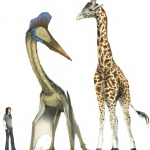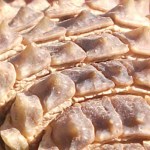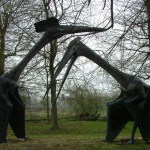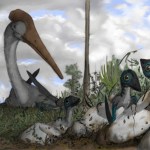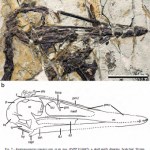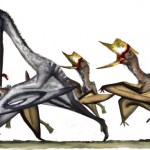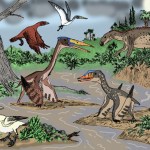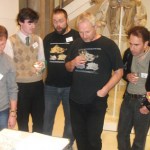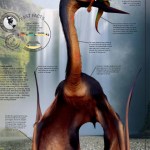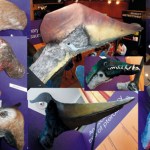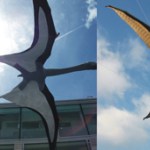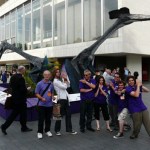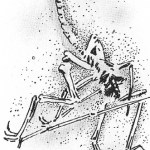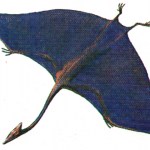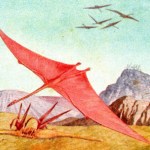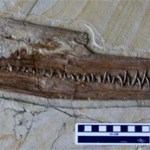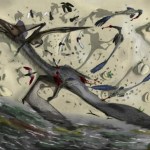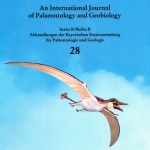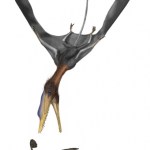pterosaurs
Pterosaurs: Natural History, Evolution, Anatomy by Mark P. Witton is a coffee-table size book rich in detail and lavishly illustrated. Witton is a pterosaur expert at the School of Earh and Environmental Sciences at the University of Portsmouth. He is famous for his illustrations and his work in popular media such as the film "Walking With Dinosaurs 3D."
The first pterosaur fossil was found in the late 18th century in the Jurassic Solnhofen Limestones, in Germany, the same excellent preservational environment that would later yield Archaeopteryx. They person who first studied it thought…
Once again I'm in that frustrating position so beloved of bloggers: where life and work just doesn't let you fritter away all those 'spare' hours preparing lengthy blog articles. In the mean time, here's one of those 'mystery pictures' to identify. What is it? Genus will do (I know the species, but that's because I have special data not available from this image). [UPDATE: no more guessing please. Answer below, comment # 31.]
While I'm here I may as well mention a few things I won't get to blog about.
Just did the trawling-the-journals thing. New items of much interest include the new long-…
During the June and July of 2010 I and a host of friends and colleagues based at, or affiliated with, the University of Portsmouth attended the Royal Society Summer Science Exhibition. As you'll know if you saw the articles and pictures I posted here at Tet Zoo, our research group set up and displayed the extremely popular Dragons of the Air exhibition. Devoted to the study of pterosaurs, it had an indoor component but also featured several life-sized, walking and flying azhdarchids.
Many people noted here and elsewhere that it would be neat, and appropriate, for these models to form part…
In January 2011, Junchang Lü, David Unwin, Charles Deeming and colleagues published their Science paper on the amazing discovery of an egg-adult association in the Jurassic pterosaur Darwinopterus (Lü et al. 2011) [the specimen is shown here: image courtesy of Junchang Lü, Institute of Geology, Beijing, used with permission]. Darwinopterus is the incredible 'transitional pterosaur', first unveiled to the world in October 2009 and rapidly becoming one of the most important pterosaurs of all in terms of what we're learning from it.
As I discussed in a Tet Zoo article published in February…
We know all too little about the biology and behaviour of the pterosaurs, the amazing, often bizarre flying reptiles of the Mesozoic Era. Most of our ideas - about feeding behaviour, locomotion, physiology and social and sexual behaviour - are inferences based on bones, or inferences based on interpretations of the bones. A new paper - published just a few weeks ago by Junchang Lü, David Unwin and colleagues in the journal Science - describes what might be one of the most interesting pterosaur fossils yet discovered, and arguably one of the most significant in terms of what it tell us about…
It's always been clear that pterosaurs were present in the Cornet assemblage (for the background on Cornet and its archosaur fossils, you need to have read part I).
However, exactly what sort of pterosaurs are present at Cornet has been somewhat uncertain: the Late Jurassic ctenochasmatoid Cycnorhamphus, ornithocheirids and the Early Cretaceous Asian dsungaripterid Dsungaripterus were all reported from the assemblage during the 1980s (e.g., Jurcsák & Popa 1984) but, as with the birds, the remains on which these identification were based (currently housed at the Tarii Crisurilor Museum…
Among one of many interesting and perplexing Mesozoic fossil assemblages is that known from Cornet, Romania. I've been really interested in this collection of archosaur remains - currently housed at the Tarii Crisurilor Museum, Oradea - ever since I first heard about it in the 1990s, and recently I've been lucky enough to work with Gareth Dyke, Michael Benton and Erika Posmosanu in re-evaluating the more controversial of the Cornet fossils: namely, those claimed to represent a bizarre and motley assortment of Mesozoic birds and pterosaurs. Our paper on these fossils has just been published…
In the previous article on the 58th Symposium on Vertebrate Palaeontology and Comparative Anatomy (SVPCA), held in Cambridge, UK, I discussed some of the work that was presented on stem-tetrapods and sauropods. This time round, we look at more Mesozoic stuff - pterosaurs in particular - before getting on to Cenozoic mammals.
Steve Sweetman presented the first outing of a new miniscule maniraptoran theropod that he and I have been working on. When it gets published, nothing will ever be the same again (massive hyperbole fully intended: Steve's talk was more to do with salamanders, anurans…
Another book with my name on it has just appeared. Again it's a kid's book: Dorling Kindersley's Know It All (Baines 2010) - a fantastically well illustrated, fact-packed encylopedia of everything science (and the successor to the highly successful 2009 Ask Me Anything). It's a multi-authored book (authors: Simone Bos, Julie Ferris, Ian Graham, Susan Kennedy, Darren Naish, Jim Pipe, Carole Stott and John Woodward). My section - titled 'Dinosaurs' - isn't just on dinosaurs; it also includes spreads on Palaeozoic tetrapods, ichthyosaurs, pterosaurs, Pleistocene mammals, and hominids. Does it…
In the previous article I discussed the outside section of the Royal Society Summer Science Exhibition's pterosaur display (hosted at Royal Festival Hall on London's South Bank). The exhibition (which finished on July 4th, sorry) incorporated three flying, life-sized azhdarchids - suspended from the two adjacent building - as well as two walking ones (the latter roughly reproducing Mark's terrestrial stalking scene).
But there was much more to the exhibit than this: it also had an indoor component. The main feature was a wall covered with life-sized pterosaur heads: it looked great, sort of…
Regular readers of Tet Zoo will have seen the little clues given here and there to a big, infinitely cool project that's been months and months in the making (here's the first big hint, from August 2009). For some time now my colleagues Dave Martill, Bob Loveridge, Mark Witton and others at the University of Portsmouth have been making life-sized pterosaur models for an exhibition. As you may know by now, this exhibition was the Royal Society Summer Science Exhibition (hosted at Royal Festival Hall on the South Bank, London), and it happened between June 25th and July 4th.
Titled Pterosaurs…
Darren is away. Back soon. Here are sneak-peeks...
The amazing freaky beast that's getting all the attention, that everyone gawps at in amazement (drumroll)...
... stands at centre-left in a white shirt. Yay, it's Witton's World of Pterosaurs. Photo above stolen from Benjamin Moon.
Dave Martill hard at work.
"Hey, it's Dave Hone, of Archosaur Musings!""Hey, it's Darren Naish, of Tet Zoo!".
Much more to come very soon...
I said in the freaky giraffoid Barosaurus article that I had one last thing to say on the 'demonic Quetzalcoatlus' meme. It's pretty incredible. Yes, world, I give you: an actual skeleton of a real 'demonic Quetzalcoatlus'. Well, a published drawing of one, anyway...
Just like the animals depicted in those various sources from the 1970s, 80s and 90s, this skeleton shows all the characteristic features of its 'artistic meme': it has a long neck (made up of many small vertebrae, and hence presumably quite flexible*), a relatively short skull, a lump-like, posteriorly projecting crest at the…
If you're a regular reader you'll have seen the recent article on those freaky, terrifying versions of the azhdarchid pterosaur Quetzalcoatlus from the 1970s and 80s. We looked at Guy Michel's version from 1979 and Richard Orr's spectacularly colourful rendition from 1984. My friend Paul Glynn reminded me recently that there's another version out there: Bob Hersey's purple Quetzalcoatlus from David Norman's 1980 Spotter's Guide to Dinosaurs & Other Prehistoric Animals (Norman 1980). I show it here. Again, freakin' terrifying.
As I said last time round, the image of the 'demonic…
By now, it's reasonably well known to interested people what azhdarchid pterosaurs looked like when alive. The answer: sort of like a cross between a giraffe and a stork, though with all of this being over-ridden by uniquely pterosaurian weirdness; membranous wings supported by giant fingers, a large cranial crest, plantigrade feet, and so on.
Why have azhdarchids become so familiar? The reconstruction of several life-sized skeletons and models mean that they've been widely exposed to the museum-going public, CG versions have recently featured on TV programmes about Mesozoic life, and a…
Earlier this year the awesome new ornithocheiroid pterosaur Zhenyuanopterus longirostris Lü, 2010 was described from the Yixian Formation of Liaoning Province, China. It has pretty incredible teeth, as well as a very interesting premaxillary crest...
And it has a lot of teeth: 86 in total in the upper jaw, and another 86 in the lower jaw (giving a total of 172). The teeth at the front of the upper jaw are about 50 mm long. This is a reasonably large pterosaur, with a wingspan of about 4 m (Lü 2010). It's clearly an ornithocheiroid, and it seems quite similar to another Yixian Formation…
Today see the launch of an outstanding new website devoted entirely to pterosaurs, the flying reptiles of the Mesozoic. What makes the site different from many specialist sources on the internet is that it was created, written and designed by specialists in the field. As such, it should prove an invaluable resource. I'll try and keep this brief, as I know you're just desperate to go over there and start looking around...
Pterosaur.net had its genesis at the Munich pterosaur meeting in 2007 when Dave Hone, John Conway, Ross Elgin, Mike Habib, Luis Rey, Lorna Steel, Mark Witton and yours truly…
Long-time readers will recall my few articles about the Peter Wellnhofer pterosaur meeting [see links below], held at the Bayerische Staatssammlung für Paläontologie und Geologie (Bavarian State Palaeontological Collection - BSPG) in Munich in 2007. The meeting, organised by Dr Dave Hone, was attended by most of the world's pterosaur workers, and was planned to be the first in a series of regular events (the next pterosaur meeting is due for 2010, and will be held in Beijing).
The plan back in 2007 was to produce a special tribute volume of the BSPG's in-house technical journal (Zitteliana…
Pterosaurs - the charismatic flying archosaurs of the Mesozoic Era - fall fairly nearly into two great assemblages: the primitive, mostly long-tailed basal forms (or 'rhamphorhynchoids') and the more strongly modified, consistently short-tailed pterodactyloids. Pterodactyloids emerged in the Middle Jurassic and persisted to the very end of the Late Cretaceous, and fossils show that they did an awful lot more in their evolution than did non-pterodactyloid pterosaurs. Several lineages evolved giant size, and bizarrely specialised skulls and dentitions show that they took to filter-feeding,…
First of all, I've been away (speaking about fossil cats again), though - as previously - you might not have known this given that a list of posts were scheduled to appear in my absence. Is there more on mesonychians to come? There might be, but I haven't yet had the time to finish it. Meanwhile....
For months and months now my esteemed colleague and coauthor Mark Witton has been working on a secret project. It's pretty incredible and the temptation to blab about it and post some of the neat photos I have has been overwhelming (one of the photos is shown below: it was taken back in May).…
